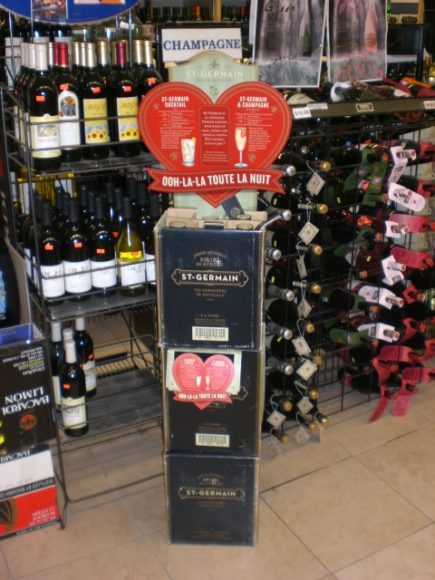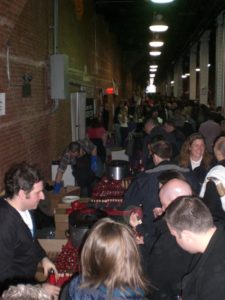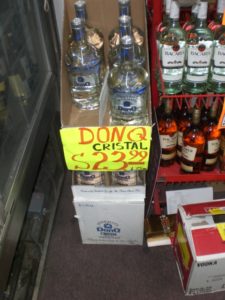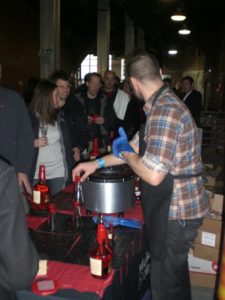>Pipeline Brands shares tips for success in this time of fragile recovery
By John Badalati, John Henry, Jim Pickett, Brad Welz and Rich Odell

The days of just cranking out bottles behind the bar or on a bottle list and calling that brand-building are gone forever.
Metro New York’s role as an indicator for national and international liquor sales means you’d be wise to keep an eye on what’s going on here if you want to successfully build your brand. The tri-state region has taken quite a hit in the last year and liquor sales, while still flowing, are tight as the financial markets directly impact consumer spending with so many financial houses here in the area fueling our economy. Fortunately, we’re seeing a rise in spending from a portion of consumers who are eager to come out of this bleak economic time and indulge in some affordable non-essential items once again.
The following is a compilation of key information from our hands-on experiences in the marketplace over the very difficult past year. It comes from the daily interaction of our street team with owners, buyers, account staff, distributor personnel, brand owners, brand representatives, other beverage industry colleagues and consumers. We hope you find it useful.
2009, What Happened?
- Top venues with stellar reputations like PDT and 11 Madison Park continued to fill seats, though check averages were off across the board.
- Steakhouses appeared down at least twenty percent across the board, as well.
- The renaissance of classic cocktails continued strong, though with waning interest in period costumes and distracting fanfare.
- The twelve to fourteen dollar cocktail became standard.
- Many new venues still emerged in this difficult year. Brooklyn continued to lead the way in openings, quality and buzz. Chains continued growing in Manhattan. The strong got stronger, and many expanded.
- Seemingly everyone got into the burger business.
- Craft beer excelled, especially locally.
- Folks further embraced value “tried and true brands” wine and spirits– making it harder for new craft and artisanal brands to break through. The key, as always, was reaching the right enlightened industry and consumers; cutting through the anxiety, fads and clutter; transferring your brand story and experience; and, at best sharing that moment, one on one. Then, in turn, forges your next lifelong brand loyalists.
In this difficult year, the personal one-on-one sales connection seemed more important than ever. It happens on the street. It was the connection PipeLine and our team of street operatives worked feverishly to tap and flow.

2010, Trend Highlights To Note
- Folks crave value in their beverage and a genuine story they can connect to. Now more than ever.
- Authenticity is key.
- Your best new consumers like the process of discovery via social networking and word of mouth. It creates a new sense of brand loyalty if they own the discovery process.
- Death of the bottle service.
- Brown spirits continue to rise, especially among women. Jameson’s is not just for St. Patty’s Day anymore.
- Local and organic are continuing trends. Folks crave Brands they can relate to from personal visits or hands-on experiences with producers or distillers.
- Price sensitivity continues. Bottle size matters.
- Big Box Stores and no-nonsense retailers who keep a consistent value oriented approach (especially with service, loyalty cards or coupons) reign.
- Folks want to entertain and celebrate a little “luxury at home” but still present simple, unique cocktails. Three of four ingredient cocktails are key, as are the best fresh ingredients. St Germain has excelled in this burgeoning home cocktail arena like no other product in recent memory; and we predict it will break through to mainstream this year.
- New web communities emerge every day. Yelp is now almost part of Google. Since wine and spirits are social products, this is a powerful medium. If the medium is the message then it is now on the web and at your phone / handheld / fingertips.
- Classic cocktails are back and here to stay on premise. But the pomp, pretensions and period costumes are out.
- Mezcal will be the new tequila within five years.
- Distributor consolidation and global supplier pressures and quotas put the squeeze on emerging artisanal brands.
- A coming trend is home cocktail making parties in the high socio-economic demographic suburbs, a la Tupperware parties of the sixties. (Savvy brands take note)
- Service is the right sell. Consultative selling is the wave of the future.
EXTENDING THE GEOGRAPHIC REACH AND FLOW BEYOND MANHATTAN
New York
The outer boroughs, Long Island, Westchester are a blend of Manhattan type consumers with a twist of normal American suburbia. These consumers were also severely affected by the economy in 2009, but they continued to explore and buy better products that they were introduced to close to home. We consider these areas to be the core expanded nuclei of growth in 2010.
Places like Huntington, Rockville Centre, White Plains, Montclair, New Brunswick and Red Bank offer us fresh new markets for seeding and culling new loyal brand consumers in 2010, both on and off-premise. PipeLine seeks to harvest this expansion in the coming year aggressively.
Upstate NY is really a collection of micro markets with a lot space in between. We see great potential for 2010 in Buffalo, Ithaca, Skaneatelees resort towns outside of Syracuse and especially the Greater Hudson River Valley up through Albany/Saratoga towards the Berkshires.
Upscale consumers are still up there, many at second or leisure homes and discovering the artisanal too. There are more and more retailers expanding their selections of the all natural, hand crafted and artisanal items that have become common place in Metro NYC. More on-trade venues are listing better beverages overall and ingredients for their cocktails. Craft beer is again leading that trend. It is happening slower than downstate – as usual – however we feel that means there is great long term potential. A “slow burn”, if you will. Great results will not come overnight, but with steady, focused market blitzes, they can come faster. Especially with the right seeds with the right venues, retailers and consumers sown in 2010.
New Jersey
Business has always been skewed heavily to the OFF trade because licenses are limited (expensive) commodities and many ON trade venues choose to avoid the expense of the license and remain BYOB. There are still plenty of licensed ON trade accounts that service their locals and more. The Northern half of the state is basically one big suburb of NYC. Many of the densely populated cities just across the Hudson or beautiful little bedroom communities a few miles further are filled with commuters that work in NYC and likely used to live there. They eat and drink in the city and bring those consumption habits home with them. Southern NJ is split between East and West. SouthEast is mostly coastal (shore) towns that are very seasonal in volume. SouthWest has Princeton and Cherry Hill and several other affluent communities that border or are close to Pennsylvania. Many upscale consumers and commuters reside in these areas. Many Pennsylvania residents cross the border to purchase their beverages because of better selection and pricing. Central NJ has characteristics of all three of the other markets, but seems to lean more toward the North because of growing density in population. Here too is a state with many pockets of potential if the right sources are tapped in 2010.

As a parting gift to our industry, now-former NJ Governor John Corzine signed legislation allowing in store tastings of spirits on May 1, 2010. Details are not yet clear of the programming. Expect PipeLine to lead the way with our seasoned street talent and our working grasp of selling artisanal brands in NY, NJ and CT stores which we finely tuned in 2009.
Connecticut
The past year marked our fully expanded foray into Fairfield County and the casinos of Connecticut. The belt of Greenwich to New London offers us a great new demographic to further tap in 2010 as our relationships mature. The retailers have embraced the artisanal here too, even as part north as Danbury. Hartford and NorthWest/Ridgefield remain yet untapped, but the pipeline will eventually flow as the artisanal wave heads north from Metro NY.
Channels: On vs. Off.
The economy in 2009 created a marked shift in how consumers were choosing to consume and where they were getting their beverages.
The Off trade remained strong throughout the year with many owners and buyers reporting being UP or FLAT in sales, even at the end of the year. Much of the end of the year volume seemed to still come from consumers shifting to home consumption and small group entertainment versus on-premise consumption. They could actually buy and consume more, with friends at home, for a lot less money than a lesser volume proposition in the on-trade. Bottle service became the exception not the rule in upscale clubs and relaxed classic cocktail lounges emerged as a trend to counter the flashier clubs of the past decade. In store, there was a fair amount of “trading down”, although the majority of that appeared to come from consumers trading from the mid-priced, mainstream, non-unique brands, down to a less expensive value proposition in the same category. Svedka, Three Olives, Pinnacle and New Amsterdam Gin had record growth years. Upscale and super premium brands did not do well. In fact many were again down i.e. Grey Goose, Bacardi, and Belvedere. While the middle tier did well to keep the consumers coming into the stores. There were also signs that some of the “old guard”, non-box retailers were losing out to newer, more exciting and adventurous, niche-focused outlets. Buyers showed that they love tastings – especially in support of a new item. They prefer their tastings to be executed by informed, articulate, passionate people who know how to educate their customers and teach them to properly understand and enjoy premium products versus agency “flavor of the day” models. PipeLine took the most effective approach by adapting to these stores’ needs; setting up tastings that helped to drive new sales—and most importantly building loyalty and business with key stores and proprietors which will be in business for decades to come. Plus a dedicated pipeline to their best customers has now been tapped and secured. No other marketing or promotion company has tapped the rising tide of the artisanal store business and their web impassioned customers like PipeLine.
The On-Premise was decimated by the downturn of the economy as over 200 accounts in NYC went out of business and the ones that did survive had to completely change the way they did business. Most offered more wines by the glass, flights, pre fixe dinners and free drink with dinner to stay afloat. Most owners said the traffic was up, but the bills were still much lower due to the fragile economy. We called this a process of “weeding out” the overpriced mediocre establishments. Again the tried and true NY legends survived and we built strong relationships with them to help keep their cocktails relevant (and of course make them better margins) while making a quality reputation for themselves at the bar.
Our opinion is that most or all of the above channel trends will continue until the economy stabilizes. In NY, the threat of wine sales in grocery stores again looms and the anxious fight is again on and heading towards a May legislative showdown. Still, overall, Off-trade will continue to show more consistent, open opportunity and LOYALTY; while the On-trade will still require focus, patience and continued follow-up and hand-holding. By mid 2010 we feel the On-trade will be moving toward its former state and again become an increasingly important to continue to build brands.
Categories That Succeed
Brands which are seeing an uptick in sales fall into a few different categories. In Metro NYC – Manhattan and Brooklyn specifically – along with specific venues or “pockets” elsewhere, there was a continued movement away from the mainstream and toward the authentic, unique and artisanal. Gin continues to rise as does Mezcal. R(h)um awaits the local Tiki revolution and revival–which is seemingly knocking on the back patio door. Brown spirits will be the next big trend with women. Savvy malt marketers take note. (Jameson has). Artisanal is the thing. And will soon take over the County of Kings. Brooklyn will soon have two operating craft distilleries come midyear. The number of working distilleries in a 90 mile radius of New York City has quadrupled in the past two years.
The growing mixology trend in spirits leads the way here. Desire for complexity, uniqueness and better craftsmanship is critical and seems to also lead the way in beer, wine and sparkling/champagne. As is typical, this trend is seen much more pronounced and faster developing in NYC. However, there are more and more on- and off-premise retailers taking up the charge outside the city – in many unexpected places – every day. The Tuthilltown whiskies are now common items in many stores, for example. These are the retailers and consumers that are changing the face of the marketplace. They might not be ready at the first presentation, but if the goods back up the story, there should be buy-in and support after repeated patient and professional effort.
Brooklyn was again the place to harvest this in 2009. PipeLine reacted and has two newly dedicated street team members now working the market there and harvesting relationships there daily. Any artisanal brand development strategy must include a platform to connect with these new potential loyalists and keep them informed—in the loop– via the web. Build them a “brand circle” as Maker’s Mark has done so well.
We at PipeLine take our expertise and decade of experience working with Brooklyn Beer and Maker’s Mark and will use those talents in 2010 to cumulatively harvest our newly commissioned brands in Brooklyn and similar satellite markets emerging in Queens, LI, CT and Northern NJ. The future is for those who harvest the best brands and the best relationships in these difficult times.
The repeat visit with the right folks and in the right consumer pockets makes for lifelong brand growth and vitality. To us it’s streamlined efficient Brand-building 101.
Brands Are Built on Quality and Price
Spirits
Brand vitality these days may simply mean not losing ground. As previously noted, all trends indicate the value premium categories look to be staying strong and holding their own. The mid-range, bland, unsupported mainstream items are losing ground as people trade down to value propositions. We also feel that the mid-range mainstream brands are losing ground because they have nothing new, exciting or compelling to justify their previously auto-response premium prices. As for the ULTRA premium category, it is beyond challenging heading into 2010. Conspicuous consumption is even now considered politically incorrect amongst those with the remaining assets.
Towards the turn of the year up to sixty percent of accounts were on COD in Metro NY and no one has the interest or cash flow to eagerly support niche ultra-premium brands who dive into the pool without marketing support, street service or a solid plan to reach that hard to find (or invisible) consumer these days. Hitting rock bottom happens fast.
Mainstream and low end have the volume but not the growth. In 2010, Profit and revenue growth continues to lie with unique, artisanal and authentic upscale brands. Long term as well.
Wines
Gone are the days when a consumer was only confronted with mainstream, familiar wine regions when they visited their local wine shop or opened the wine list. What was only a few years ago a very exclusive and attractive industry across the board has now become somewhat of a new world bloodbath. Chilean, Argentine and New Zealand wines continue to excel or even thrive. California wines are holding their own. The amount of good wine at good prices in the market is overwhelming. It is a good time to be a wine buyer and a wine drinker, because the choices are endless and gratifying across the board. Build that wine cellar if you can. There were more new wine distributors formed last year than any other period in the past, continuing to show that you don’t need a big name to sell wine. Think Verity which broke off from Lauber as a pointed example. Price point and quality have become the key. Being a wine salesperson, especially for a major distributor, is another story altogether.
Sparkling/Champagne
The story with the sparkling wines and champagnes reflects what the wine category is doing. It has gotten extremely competitive, but it is much more difficult to make very good champagne. Even harder to sell! Prosecco, Cava, and Sparkling wines have grown in same cases over fifteen percent and now taken a big bite out of the large Champagne houses, even with them lowering prices. The key to developing a brand is what built the wine business in the US years ago – education and tasting. There are a lot more “everyday” opportunities for champagne now and into the future as the American palate continues to advance.
Beer
It’s all about craft, specialty and imports. That is where all the growth and profit is. The mainstream brands dropped a few percent (for the first time in decades) and now battle it out to be the “loss leader” at minimal profit for anyone in the food chain; while the craftsmanship and creativity of specialty and premium import beers win more and more of the increasing population of consumers with further developing and sophisticated palates. Brooklyn ran a full page ad a few times in the NY Times this year on their artisanal, Williamsburg produced Local 1 and Local 2 bottle fermented ales.

How to get it off your shelves
Being a loss leader shouldn’t be enough if you’re serious about success. That success comes from recognizing that the days of distributors actually “building” a brand are essentially dead and gone. Global brand consolidation has been the catalyst to national distributor consolidation. There are now less and less quality options for quality attention at the local and regional distributor level – especially in the major markets– for new, independently owned brands. The multi-nationals and multi-brand companies get all the attention, and the quotas, first and foremost, all the time. The rest of the brands in a distributor’s portfolio typically have to get very aggressive and creative to make their mark before they get any regular attention – or come to expect little to no sales. Salespeople react more to the pressure of top down management quotas than they do to the rewards of financial incentives and new brand and revenue building. No indications of any real change are in sight. Brand owners must now be prepared to invest directly and sufficiently for at least a few years in order to get noticed and supported.
That kind of support that is the new world of brand building is what PipeLine does best. Tactics to enhance your brand image and broaden your exposure include: in-store tastings in the right demographic neighborhoods, quality mixers and ingredients, nurturing and harvesting the right top industry contacts and influencers, daily street based organic brand building, harvesting new accounts, window display opportunities, catalog listings, cocktail list development, unique neighborhood sampling and charity events. CKTL jams, sampling events and clubs, brand and market blitzes, and guerilla marketing opportunities. This is how it works.
Copyright 2010 PipeLine Brands LLC
